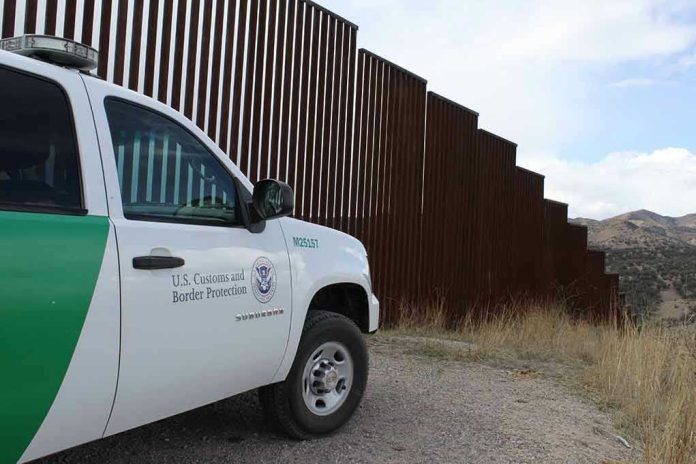
Border crossings have plummeted to historic lows under President Trump’s new immigration crackdown, and the administration is sending a clear message: no deals, no compromises, and certainly no more handouts for illegal immigrants.
At a Glance
- Border Patrol encounters at the southern border have dropped by over 90% since Trump’s 2025 executive orders took effect.
- The administration refuses to negotiate with Democrats on immigration, citing years of failed enforcement and rising crime under previous policies.
- Federal agencies are aggressively enforcing new rules, ramping up removals and ending policies like TPS and broad asylum eligibility.
- Legal challenges from left-leaning groups and blue states are piling up, but the White House remains undeterred.
Trump’s No-Compromise Stance: Border Security Comes First
The Trump administration’s 2025 immigration overhaul has delivered what it promised: a border that is, by all credible accounts, more secure than at any point in modern American history. New data from U.S. Customs and Border Protection shows that average monthly border encounters crashed to less than 7,200 in March 2025—a jaw-dropping 93% drop from the Biden years, when monthly encounters hovered near 160,000. Gotaways—those who managed to slip through—are down by 95%. The administration says migrant crossings are down a staggering 99.99%. The White House credits the sharp decline to a series of executive orders issued immediately after inauguration, which suspended most asylum claims at the border, ramped up removals, and eliminated loophole-ridden policies like Temporary Protected Status. Democratic lawmakers, predictably, are howling about humanitarian obligations. But the facts are the facts: after years of chaos, the border is shut tight, and the incentives for illegal crossings have all but evaporated.
After four years of soft-on-crime, open-border policies that saw over 11 million border encounters and a surge in criminal aliens roaming American streets, the Trump administration’s approach is a stark—and, for many Americans, a welcome—departure. ICE’s Non-Detained Docket had swelled to more than 650,000 criminal aliens by late 2024. The current crackdown is not just about numbers; it’s about restoring the rule of law and putting American citizens first. The administration has made it plain: there will be no negotiations with Democrats who have spent years undermining enforcement, demonizing agents, and prioritizing illegal immigrants over working families.
No Deals, No DACA, No Amnesty: A Hard Line That’s Delivering Results
President Trump and his policy architects have taken a sledgehammer to the failed status quo. The Project 2025 blueprint, now being implemented at a breakneck pace, calls for the end of broad humanitarian waivers, the expansion of mandatory E-Verify for employers, and the repeal of programs like DACA and TPS—measures that, for years, have acted as magnets for illegal entry and overstayed visas. DHS and ICE are aggressively enforcing the new rules, detaining and removing those without legal status, and pressuring sanctuary jurisdictions to comply or face federal penalties. Executive actions in June further restricted entry of foreign nationals on the grounds of national security and public safety. The administration has signaled that it will not be swayed by lawsuits or media outrage: executive authority is being wielded to its fullest extent to protect Americans and restore sovereignty.
Legal and advocacy groups are scrambling to file challenges, particularly against efforts to restrict birthright citizenship and suspend asylum. But the administration, backed by a coalition of conservative policy groups, argues that the courts have long enabled executive overreach and that it’s time to reassert congressional and presidential authority over immigration. Critics allege humanitarian crises at the border and in neighboring countries, but the White House points to the decades-long failure of “catch-and-release” approaches and the overwhelming costs to public safety, national security, and the American taxpayer.
Economic, Legal, and Social Impact: Who Wins and Who Loses?
For American workers and families, the administration’s hard line is already having measurable effects. Employers in agriculture, hospitality, and tech sectors are feeling the pinch as the labor pool contracts, but the administration is unapologetic: the priority is to protect wages and job opportunities for citizens and legal immigrants. The days of employers exploiting cheap, illegal labor are coming to an end. Meanwhile, communities along the border are seeing a reprieve from the economic and social strain that accompanied years of unchecked crossings and criminal activity. Law enforcement officials report fewer gotaways, fewer high-speed chases, and a renewed sense of order.
Yet the administration is under no illusions about the challenges ahead. Legal battles over birthright citizenship and the scope of executive authority are expected to reach the Supreme Court. Blue states and advocacy groups are mobilizing to block or delay enforcement, but the White House remains undeterred. The President’s message could not be clearer: after years of failed experiments and open-border fantasies, the era of compromise is over. American sovereignty and security come first, and this administration has no reason to negotiate that away—least of all to the party that helped create the mess in the first place.









